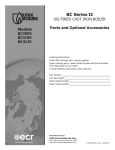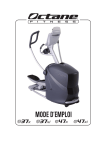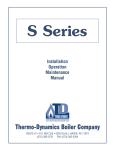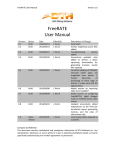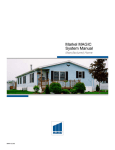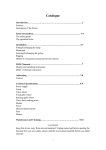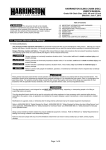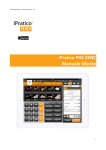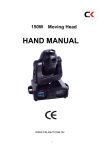Download Utica Boilers BC Series II Operation and Installation Manual
Transcript
Models BC3095 BC4100 BC4115 BC Series II OIL-FIRED CAST IRON BOILER INSTALLATION, OPERATION & MAINTENANCE MANUAL Maximum Allowable Working Pressure 30 psi. Manufactured by: ECR International, Inc. 2201 Dwyer Avenue, Utica NY 13501 web site: www.ecrinternational.com An ISO 9001-2008 Certified Company P/N 240009511, Rev. B [12/2014] SAFETY INFORMATION Ratings, Data, And Dimensions������������������������������������������������������������������������ ......3 Installation Procedure������������������������������������������������������������������������������������������ 4 Ventilation And Combustion Air����������������������������������������������������������������������������� 5 Connecting Supply And Return Piping��������������������������������������������������������������������� 7 Venting System Inspection & Installation...............................................................12 Electrical Wiring������������������������������������������������������������������������������������������������ 14 Wiring Diagrams������������������������������������������������������������������������������������������������ 15 Operating Instructions��������������������������������������������������������������������������������������� 16 Maintenance Procedures������������������������������������������������������������������������������������� 18 Service Checklist����������������������������������������������������������������������������������������������� 19 ! WARNING All boiler and venting installations shall be done by qualified agency and in accordance with appropriate Manufacturer’s Installation, Operation and Maintenance Manual. Installing or venting boiler or any other appliance with improper methods or materials could result in serious injury or death due to fire or to asphyxiation from poisonous gases such as carbon monoxide which is odorless and invisible. KEEP THIS MANUAL NEAR BOILER RETAIN FOR FUTURE REFERENCE ! WARNING IMPORTANT: Read the following instructions COMPLETELY before installing!! Keep boiler area clear and free from combustible materials, gasoline and other flammable vapors and liquids. Safety Symbols & Warnings DO NOT obstruct air openings to the boiler room. The following defined symbols are used throughout this manual to notify the reader of potential hazards of varying risk levels. ! Modification, substitution or elimination of factory equipped, supplied or specified components may result in personal injury or loss of life. TO THE OWNER - Installation and service of this boiler must be performed by a qualified installer. DANGER Indicates a hazardous situation which, if not avoided, WILL result in death or serious injury. TO THE INSTALLER - Leave all instructions with boiler for future reference. ! WARNING Keep boiler area clear and free from combustible materials, gasoline and other flammable vapors and liquids. Indicates a hazardous situation which, if not avoided, could result in death or serious injury. ! DO NOT obstruct air openings to boiler room. CAUTION To the owner: Installation and service of this boiler must be performed by qualified installer. Indicates a hazardous situation which, if not avoided, could result in minor or moderate injury. To the installer: Leave all instructions with boiler for future reference. NOTICE Used to address practices not related to personal injury. Installation in Commonwealth of Massachusetts must be performed by Licensed Plumber or Licensed Gas Fitter. 2 DIMENSIONS Figure 1- Dimensions Table 1 DIMENSIONS Length Front of Jacket Flue Tankless of Flush to Center Line Outlet Coil to Back Boiler No. Jacket of Flue Outlet Diameter of Jacket BC3 BC4 -A19" 23" -B9 ¾" 11¾" 3 -C6" 6" -D8⅞ 12¾ RATINGS, DATA, AND DIMENSIONS Table 2 RATINGS & DATA AHRI Oil Burner Input(1) AHRI Net Min. Natural Draft Ratings(2)(4) A.F.U.E. Chimney Size Rating Water MBH Round Square G.P.H. MBH(4) Heating Capacity MBH(4) BC3095 0.95 133 114 99 84.0 6 8x8x15 BC4100 1.00 140 121 105 85.0 6 8x8x15 BC4115 1.15 161 137 119 84.0 6 8x8x15 Boiler Model Number(1) NOTES: 1. AHRI burner capacity is based on an oil heating value of 140,000 Btu/gal and with 13% CO2. 2. Net AHRI Water Ratings shown are based on a piping and pickup allowance of 1.15. 3. Consult manufacturer before selecting boiler for installations having unusual piping and pickup requirements, such as intermittent system operation, extensive piping. 4. For forced hot water heating systems where boiler and all piping are within the area to be heated, select boiler on basis of its Heating Capacity. 5. Nozzle listed for use with Beckett Burner. 6. Electrical service to be 120 Volts, 15 Amps, & 60 Hz. Table 3 TANK-LESS WATER HEATER CAPACITIES Boiler Model Number Input Tankless Tankless Heater Rate Heater Capacity Intermittent G.P.H. Number Draw G.P.M. Boiler Water Content (Gallons) BC3095 0.95 L-24 3.25 6.7 BC4100 1.00 L-24 3.25 8.2 BC4115 1.15 L-24 4.00 8.2 STANDARD EQUIPMENT: Crated Boiler, Flush Jacket, Oil Burner, Target Wall/Liner, Circulator-1¼", Safety Relief Valve, Temperature Pressure Gauge, Drain Valve, Wiring Harness, Supply Tapping 1¼", Return Tapping 1¼", High Limit and Circulator Control, Primary Control. For Tankless Heater Units-add Low Limit. 4 INSTALLATION PROCEDURE ! WARNING ! DANGER Improper installation, adjustment, alteration, service or maintenance could result in death or serious injury. Fire hazard. Do not install boiler on combustible flooring or carpeting. Failure to follow these instructions WILL result in death or serious injury. •Installation shall conform to requirements of the authority having jurisdiction and shall take precedence over the general instructions of this manual. Table 4 Clearance To Combustibles •Where required by authority having jurisdiction, installation shall conform to Standard for Controls and Safety Devices for Automatically Fired Boilers, ANSI/ ASME CSD-1. •Locate boiler in front of final position before removing crate. Provide solid level base as near chimney as possible and centrally located with respect to the heat distribution system as practical. TOP 24 IN. FRONT 24 IN. FLUE CONNECTOR 9 IN. REAR 6 IN. LEFT SIDE 6 IN. RIGHT SIDE 24 IN. NOTE: Clearance for access should exceed fire protection clearance. •Allow 24 inches in front, top and right hand side for servicing and cleaning or removing tankless water heating coil. •When installed in utility room, door should be wide enough to allow largest boiler part to enter, or to permit replacement of another appliance such as water heater. •Boiler shall be installed such that the oil ignition system components are protected from water (dripping, spraying, rain etc.) during appliance operation and service. •Remove crate and plastic protective wrapper, inspect for damage. •Move boiler to permanent position by sliding or walking. 5 VENTILATION AND COMBUSTION AIR Table 5 COMBUSTION AIR REQUIREMENTS (Minimum Opening Requirement) BTU/Hr Input Outside Unconfined Area* (Mbh) Combustion Air 1 Sq. In./5000 BTU/Hr (Step 4) 133 140 161 27 28 32 Inside Combustion Air 1 Sq. In./1000 BTU/Hr (Min. 100 Sq. In.) 133 140 161 Confined Area** Outside Combustion Air Vertical Ducts 1 Sq. In./4000 BTU/Hr Horizontal Ducts 1 Sq. In./2000 BTU/Hr (Figures 2 & 3) (Figure 4) 33 35 40 67 70 81 * A space whose volume is not less than 50 cubic feet per 1000 BTU/Hour of all appliances installed in that space (cubic feet of space = height x width x length) ** A space whose volume is less than 50 cubic feet per Mbh of all appliances installed in that space (cubic feet of space = height x width x length) ! WARNING 4. When air for combustion and room ventilation is from Asphyxiation, fire hazard. Air openings to combustion area SHALL not be obstructed. Provide adequate supply of combustion air in accordance with Installation Code for Oil Burning Appliances, CSA 139. inside buildings, the confined space shall be provided with two permanent openings, one starting 12 inches from the top and one 12 inches from the bottom of the enclosed space. Each opening shall have a minimum free area of 1 square inch per 1,000 BTU per hour of the total input rating of all appliances in the enclosed space, but must not be less than 100 square inches. These openings must freely communicate with the interior areas having adequate infiltration from the outside. See Figure 2. ! WARNING Asphyxiation, fire hazard. Do not obstruct air openings to combustion area. Follow instructions below, to maintain adequate combustion air. 1. Ventilation of boiler room must be adequate enough to provide sufficient air to properly support combustion and venting. 2. When the boiler is located in an unconfined space in a building of conventional construction frame, masonry or metal, infiltration normally is adequate to provide air for combustion and ventilation. However, in any building which has been altered to conserve energy or to minimize infiltration, the boiler area should be considered as a confined space. If there is any doubt, install air supply provisions for combustion and ventilation in accordance with requirements of authority having juridiction, or in absence of such requirements, Air for Combustion and Ventilation of the NFPA 31. Figure 2Combustion and Room Air From Inside Buildings CHIMNEY OR L TYPE VENT PIPE BASEBOARD 3. When the boiler is installed in an unconfined space, in a building of unusually tight construction, air for combustion and room ventilation must be obtained from outdoors or from spaces freely communicating with the outdoors. A permanent opening or openings having a total free area of not less than 1 square inch per 5,000 BTU per hour of total input rating of all appliances shall be provided. Ducts may be used to convey make-up air from the outdoors and shall have the same cross-sectional area of the openings to which they are connected. VENT PIPE 12" VENTS 12" 6 VENTILATION AND COMBUSTION AIR 5. When the boiler is installed in a confined space and Figure 3Boiler Installed In Confined Space - Air From Outdoors all air is provided from the outdoors, the confined space shall be provided with two permanent openings, one commencing within 12 inches from the top and one commencing 12 inches from the bottom of the enclosure. The openings shall communicate directly, or by ducts, with the outdoors or spaces (crawl or attic) that freely communicate with the outdoors. One of the following methods must be used to provide adequate air for ventilation and combustion. A. When directly communicating with the outdoors, each opening shall have a minimum free area of 1 square inch per 4,000 BTU per hour of total input rating of all equipment in the enclosure. See Figure 3. B. When communicating with the outdoors by means of vertical ducts, each opening shall have a minimum free area 1 square inch per 4,000 BTU per hour of total input rating of all appliances in the enclosed space. See Figure 4. C. If horizontal ducts are used, each opening shall have a minimum free area 1 square inch per 2,000 BTU per hour total input rating of all appliances in the enclosed space. See Figure 5. Figure 4Vertical Ducts D. When ducts are used, they shall be of the same cross sectional area as the free area of the area of the openings to which they connect. The minimum dimension of rectangular air ducts shall not be less than 3 inches. 6. In calculating free area using louvers, grills or screens for the above, consideration shall be given to their blocking effect. Screens used shall not be smaller than 1/4 inch mesh. If the free area through a design of louver or grill is known, it should be used in calculating the size opening required to provide the free area specified. If the design and free area is not known, it may be assumed that wood louvers will have 20-25% free area and metal louvers and grills will have 60-75% free area. Louvers and grills shall be fixed in the open position or interlocked with the boiler so that they are opened automatically during boiler operation. Figure 5Horizontal Ducts 7 CONNECTING SUPPLY AND RETURN PIPING Circulators in the following illustrations are mounted on system supply side, mounting on system return side is also acceptable practice. Figure 6Boiler Used In Connection With Refrigerated System Figure 7Bypass Piping Typically Used With Baseboard Heating 1. Connect supply and return piping as suggested in B. Use appropriate valves to prevent chilled medium from entering heating boiler. 2. During the heating cycle open valves A and B, close valves C and D. Figure 6. When the boiler is used in connection with refrigerated systems: A. Chilled medium MUST BE IN PARALLEL with boiler. 8 CONNECTING SUPPLY AND RETURN PIPING 3. During heating cooling cycle open valves C and D, close B. This method is used to protect boilers from condensate forming due to low temperature return water. Generally noticed in large converted gravity systems or other large water volume systems. See Figure 8. valves A and B. A. Maintain a minimum clearance of one (1") inch to hot water pipes. In air handling units where they may be exposed to refrigerated air circulation, the boiler piping system MUST be supplied with flow control valves or other automatic means to prevent gravity circulation of the boiler water during the cooling cycle. 4. Hot water boilers installed above radiation level must be provided with a low water device either as part of the boiler or at the time of boiler installation. 5. When a boiler is connected to a heating system that utilizes multiple zoned circulators, each circulator must be supplied with a flow control valve to prevent gravity circulation. C. This method is used to protect boilers from condensate forming as well as protecting the heating system from high water temperature. See Figure 9, page 9. 7. Note: When using bypass piping, adjust valves A and B until desired system temperature is obtained. 8. Bypass loop piping must be same size piping for supply and return. 9. Typical installation using circulators is shown in Figure 10, page 9. 10. Typical installation using zone valves is shown in * Reduced pressure back flow preventer must be present under provisions required by the Environmental Protection Agency, (EPA). Figure 11, page 10. 11. See Figure 12, page 10 for typical piping for domestic hot water heater. 6. Bypass piping is an option which gives the ability to adjust the supply boiler water temperature to fit the system or condition of the installation. Although, this method of piping is not typically required for baseboard heating systems. A. This method is used to protect systems using radiant panels and the material they are encased in from high temperature supply water from the boiler. See Figure 7, page 7. Figure 8Bypass Piping Option For Converted Large Volume Systems 9 CONNECTING SUPPLY AND RETURN PIPING Figure 9Bypass Piping Option Used to Protect From Converted Systems With High Water Temperature Figure 10 Typical Installation With Circulators 10 CONNECTING SUPPLY AND RETURN PIPING Figure 11 Typical Installation With Valves Figure 12 Typical Installation With DHW 11 CONNECTING SUPPLY AND RETURN PIPING ! WARNING Burn or Scald Hazard. Discharge line shall be installed to relief valve outlet connection to avoid burns, scalding, or water damage due to discharge of steam and/or hot water during operation. Discharge line shall: •Use ¾" or larger pipe. •Use pipe suitable for temperatures of 375°F (191°C) or greater. •Individual boiler discharge piping shall be independent of other discharge piping. •Size and arrange discharge piping to avoid reducing safety relief valve relieving capacity below minimum relief valve capacity stated on rating plate. •Run pipe as short and straight as possible to location protecting user from scalding and properly drain piping. •Install union, if used, close to safety relief valve outlet. •Install elbow(s), if used, close to safety relief valve outlet and downstream of union (if used). •Terminate pipe with plain end (not threaded). Refer to local codes and appropriate ASME Boiler and Pressure Vessel Code for additional installation requirements. 12. Install limit sensor in supply pipe. See Figure 13. Figure 14 • Install nipple and tee. • Install well in tee. • Insert sensor into well. Secure with clip. Safety Relief Valve With Discharge Line Safety Relief Valve • Secure sensor wire to jacket with cable clamps. • Plug sensor wire into limit. See wiring diagram. Discharge Line 13. Install safety relief valve. See Figure 14. • Install safety relief valve in rear section using provided nipple and elbow. • Install discharge piping. Follow instructions in Warning above. Figure 13 Tee Limit Sensor Well Check local codes for maximum distance from floor or allowable safe point of discharge. Limit Sensor Supply Pipe Cable Clamps Temperature Pressure Gauge Limit 12 VENTING SYSTEM INSPECTION & INSTALLATION ! WARNING ! WARNING Figure 15 Chimney Installation Boiler and venting installations shall be performed by a qualified expert and in accordance with the appropriate manual. Installing or venting boiler or other appliances with improper methods or materials may result in serious injury or death due to fire or to asphyxiation from poisonous gases such as carbon monoxide with is odorless and invisible. Do not connect boiler to any portion of mechanical draft system operating under positive pressure. •Inspect chimney. Verify construction supplies with requirements of authority having jurisdiction, or in absence of such requirements, NFPA 211: Standard for Chimneys, Fireplaces, Vents and Solid Fuel-Burning Appliances. •Install boiler into chimney which has masonry or metallic chimney liner. Table 6 CHIMNEY OR VENT SIZES •Unlined chimney will have leaks that will cause poor chimney performance (no draft), and could result in positive pressure in the combustion chamber. MODEL NUMBER BC3 BC4 •Horizontal portions of venting system should not exceed 10 ft. in length. Horizontal lengths over 10 ft. will have negative effect on chimney performance. •Chimney should extend at least 2 ft. above any portion of building within 10 ft. See Figure 15. It should produce a -.06 to -.08 inch W.C. draft, as measured with draft gauge between boiler and barometric draft control while maintaining .02 inch W.C. negative draft in combustion chamber. . See "Chimney or Vent Sizes" chart for recommended minimum and maximum chimney or vent sizes. •Inadequate draft will cause improper combustion, resulting in dirty flue ways and high fuel bills. •Connect flue pipe same size as boiler outlet to chimney, sloping upward continuously toward the chimney approximately ¼" per foot. Bolt or screw joints together to avoid sag. •If oil fired water heater is vented into same flue as boiler, provide separate hole into chimney whenever possible. When this isn’t possible, use “Y” connection in flue pipe, using separate draft regulator for each unit. When chimney will not provide adequate draft to handle input from water heater and boiler simultaneously, wire units so only one will operate at a time, favoring water heater. 13 ROUND INCHES MIN MAX 6 8 6 8 SQUARE HEIGHT (FT) INCHES MIN MAX MIN MAX 8x8 8x10 15 40 8x8 8x10 15 40 OIL TANK AND PIPING Oil Tank and Piping Installation •Install oil tank and piping in accordance with the National Board of Fire Underwriters and local regulations. •Oil storage tank, vent, fill pipe and caps should be as prescribed by local codes. In no case should the vent pipe be smaller than 1¼" I.P.S. The fill pipe should not be less than 2" I.P.S. •Suction line from tank to burner shall be one continuous piece of tubing to prevent air entering the line. A. Suction line, must be ⅜" O.D. copper tubing for runs of 50 feet or less, and ½" O.D. for longer runs. B. Install oil return line same size suction line. Use on any installation where bottom of tank is below fuel unit of burner. C. Oil lines should be buried or otherwise protected from mechanical injury. D. Flare fittings on all oil lines are recommended. E. Compression fittings on suction line often allows air to be drawn into fuel pump, making it difficult to maintain oil pressure at the nozzle. F. Do not run overhead fuel lines from tank to oil burner. Figure 16 Typical Installation Single Pipe Oil System •Install fuel pump connections and by-pass according to instructions attached to the fuel pump. If tank is more than 20' from boiler, install two stage fuel unit in place of single stage pump supplied as standard equipment with burner. Verify rotation and speed are same and pump is suitable for burner horsepower rating. •Install oil line filter and shut-off valve in suction line. Install shut-off valves in both suction and return lines at burner for servicing burner. Allow extra tubing at burner so burner may be removed from boiler for cleaning without disconnecting tubing. See Figure 16 and Figure 17.Optional flexible oil line is available. Figure 17 14 Typical Installation Two Pipe Oil System ELECTRICAL WIRING ! WARNING Electrical shock hazard. Turn OFF electrical power supply at service panel before making electrical connections. Failure to do so could result in death or serious injury. Install electrical wiring in accordance with requirements of authority having jurisdiction, or in the absence of such requirements, NFPA 70: National Electric Code. A separate electrical circuit should be run from the entry box with a fused disconnect switch in this circuit. See wiring diagram See Figure 18 . Thermostat Installation 1. Thermostat should be installed on an inside wall about four feet above the floor. 2. NEVER install a thermostat on an outside wall. 3. Do not install a thermostat where it will be affected by drafts, hot or cold pipes, sunlight, lighting fixtures, television, fireplaces, or chimneys. 4. Check thermostat operation by raising and lowering thermostat as required to start and stop the burner. 5. Instructions for the final adjustment of the thermostat are packaged with the thermostat (adjusting heating anticipator, calibration, etc.). Wiring for zone valve installations are furnished with zone valve packages. 15 WIRING DIAGRAMS 16 · Wiring Diagram · Figure 18 OPERATING INSTRUCTIONS Sequence of Operation •Thermostat calls for heat. •Circulator turns on. •Limit checks boiler water temperature. Burner ignition delayed until limit determines call for heat cannot be met by residual heat in boiler and heat distribution system. A.See limit literature for additional information. B.Burner delay by-passed for tankless heat call for heat. Burner ignition begins immediately. •Burner and circulator operation continues until thermostat stops call for heat. Figure 19 Boiler Controls JACKET TOP PANEL TEMPERATURE PRESSURE GAUGE LIMIT CONTROL UPPER FRONT JACKET PANEL 1/4" SLOT WIRE HARNESS CIRCULATOR HOT LOWER FRONT JACKET PANEL OIL BURNER WIRE HARNESS BURNER A1454 17 OPERATING INSTRUCTIONS ! Burner Operation Instructions WARNING •Use provided ¼" diameter slot in inspection cover plate to take draft readings in combustion chamber. See Figure 19, page 16. Boiler and venting installations shall be performed by a qualified expert and in accordance with the appropriate manual. Installing or venting boiler or other appliances with improper methods or materials may result in serious injury or death due to fire or to asphyxiation from poisonous gases such as carbon monoxide with is odorless and invisible. •Drill ¼" diameter hole in flue pipe between boiler and barometric damper (if used) to take draft, CO2, smoke and temperature readings. Plug hole when done. •Adjust air shutter on oil burner to obtain “trace” of smoke. Measure CO2 at this point. •Increase air adjustment to lower CO2 approximately one percent. Start-Up And Adjustment Of Oil Burner NOTE: Bacharach or Dwyer test kits include these instruments. •Verify minimum negative .02 w.c., (water column), “overfire” draft and zero smoke. (See oil burner instructions for nozzle and electrode setting) 1. Verify oil burner nozzle is tight in adapter. Burner 2. 3. 4. 5. 6. 7. 8. 9. •If -.02 w.c. “overfire” draft can not be maintained, changes and/or modifications may be required in venting or chimney. mounting bolts should be tight. Check electrode setting, may have been jarred out of position during transportation. Lubricate burner motor if necessary. Set room thermostat to call for heat, or jump thermostat contacts on boiler control. Open all oil line valves. Turn service switch on. Burner will start. On one pipe fuel systems only, bleed pump as soon as burner starts. Allow oil to run until all traces of air in suction line disappear. Turn “OFF” burner and install pressure gauge port on pump. Start burner and check oil pressure for 140 psi adjust if necessary. •See table below as guideline for initial start-up. Make final adjustments using combustion instruments. Check safety control circuit after burner adjustments have been made for satisfactory performance. A. High limit control: remove cover and note temperature setting. See Figure 19, page 16. With burner operating, decrease setting to minimum point. When boiler water temperature exceeds set point, high limit switch will open, shutting off power to oil burner. Return setting to desired high limit point. Burner should start. B.Verify Primary Control and Flame Sensor •Flame Failure - simulate by shutting off oil supply with hand valve while burner is on. Sixty seconds after flameout, safety switch locks out, ignition stops, motor stops and oil valve - when used - closes. To restart, open oil supply valve and reset safety switch. •Ignition Failure - With burner off, close oil supply valve and run through start-up procedure. Safety switch should lock out as in flame failure. •Power Failure - Turn off main power supply switch while burner is operating. When burner stops, restore power and burner should start. If operation is not as described as above, check wiring and controls. Boiler Model No. BC3095 BC4100 BC4115 Table 7 Oil Burner Settings Head Type Static Disc F3 F3 F6 2¾ U 2¾ U 2¾ U Air Band Air Shutter Nozzle Furnished Settings Settings 0 0 0 6 7 6 Delevan 0.85x 80°B Delevan 0.85x 80°B Delevan 1.00x 80°B Pump Pressure (psi) 140 140 140 NOTES: Information in above table uses Beckett model AFG burner for both model numbers BC-3 and . BC-4 BC4115 is rerated boiler which requires rerate kit. 18 MAINTENANCE PROCEDURES Regular Maintenance NOTICE •Inspect venting system at start of each heating season. Check vent pipe from boiler to chimney for signs of deterioration by rust or sagging joints. Repair if necessary. Do not overtighten bolts. Periodic inspection and tightening of tankless heater/ cover plate bolts reduce the risk of leaks. CAUTION: Do not overtighten bolts. •Remove vent pipe at base of chimney or flue. Use mirror, check for obstruction. Instructions For Removing Oil Burner •Verify compliance to the latest revision of the NFPA 211. 1. 2. 3. 4. 5. •Operate lever of safety relief valve on boiler periodically to verify that it is functioning properly. Open pressure relief valve before water pressure exceeds 30 psi reading on gauge. If pressure is exceeded and pressure relief valve leaks water when boiler is operating at normal pressures, replace immediately. Corrosion can build at valve seat and prevent functioning as safety device. Periodically or at start of heating season inspect boiler, vent and vent pipe for accumulation of soot or scale deposits. When soot is present on section walls and flueways, improper combustion results, causing additional sooting and scaling until flueways are completely closed. B. Carefully vacuum debris from combustion chamber. Inspect combustion chamber for signs of damage, i.e. cracks. C. In event combustion chamber is damaged, contact qualified service agent to replace immediately. Allow boiler to cool down. Remove three (3) 1/2" nuts from burner flange. Close oil valve. See Figure 16 and Figure 17, page 13. Disconnect oil line from burner. Recommend replacing nozzle at start of each heating season. Annual Inspection - Before Start of Heating Season A. To remove soot and scale from flueways, remove top jacket panel, top clean-out plate and burner. See instructions on Removing Oil Boiler. Use wire brush, brush soot and scale into combustion chamber where it can be removed through burner opening. Turn off power to boiler. Lubricate burner motor and circulator motor - if required with few drops of good grade of light motor oil. Do not over oil. Have qualified service agent service burner and check controls and electrodes for carbon or cracks in insulators. Adjust burners to produce conditions shown in Start-up and Adjustment of Oil Burner procedure. Instructions For Replacing Oil Burner 1. 2. 3. 4. 19 Reconnect oil line. Open oil valve. See Figure 16 and Figure 17, page 13. Install and tighten three (3) 1/2" nuts on burner flange. Turn on power to boiler. SERVICE CHECKLIST Inspect Chimney and Flue Pipe Inspect and Clean Appliance Inspect Oil Line - Size/Leaks Inspect Electrical Connections Install New Filter Room Make-up Air Electrode Setting Proper Light-Off (Hot & Cold) [ [ [ [ [ [ [ [ X X X X X X X X ] ] ] ] ] ] ] ] Controls and Safety Devices Nozzle-Size, Angle, Type Pump Pressure/Vacuum Line Voltage/Motor Amps Smoke Test Draft-Overfire/In Flue CO2 or O2 Flue Gas Temperature [ [ [ [ [ [ [ [ X * * * * * * * ] ] ] ] ] ] ] ] * Measure with instruments and record results below. SERVICE RECORD Date Nozzle Size Angle Pump Pressure Smoke# PSI Type Draft O.F. INF CO2 Flue or O2 Temp °F UTICA BOILERS 2201 Dwyer Avenue Utica NY 13501 web site: www.ecrinternational.com




















